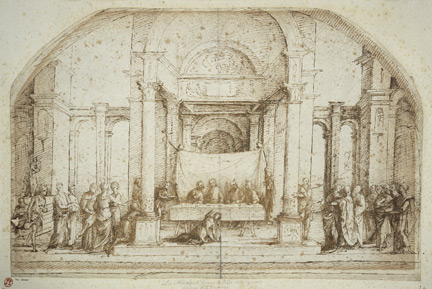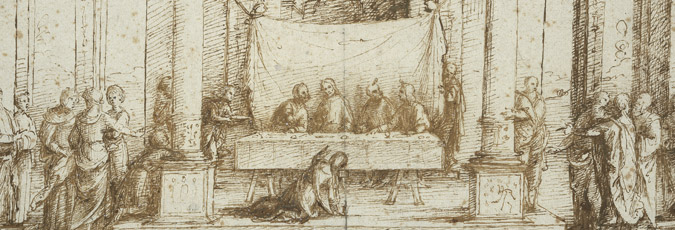Lorenzo Costa (about 1459/60–1535)
'Christ in the House of Simon the Pharisee', about 1500
Pen and brown ink, 29.6 x 45.3 cm (arched top)
Christ Church Picture Gallery, Oxford
© By permission of the Governing Body, Christ Church, Oxford

The Ferrarese painter Lorenzo Costa spent the greater part of his career in Bologna, where he was the favoured artist of the ruling Bentivoglio family (until their expulsion from the city in 1506), and subsequently in Mantua, where he succeeded Andrea Mantegna as court painter. Much of his early career remains a matter for speculation, as does a secure corpus of his work as a draughtsman. The present sheet is probably Costa’s most important surviving work on paper. It is an assured and complete study for the representation of a sacred history within a fully realised architectural context. The architecture of Costa’s composition underpins his narrative construction, and gives it structure and meaning.
The subject of this drawing is generally described as the anointing of Christ’s feet in the house of Simon the Pharisee. The episode of Christ being anointed by a sinful woman while he was seated at dinner is told in all four of the Gospels, but with slight variations. Three of the accounts situate the dinner in Bethany (either with Simon the Leper, or with Lazarus), while the fullest narrative (in the Gospel of Luke) sets the event in the house of Simon the Pharisee. There is no reason to believe that the two Simons were the same person, and thus three separate (but related) meals seem to have taken place.
In Catholic tradition, these were often confused, their details being conflated into one prefiguration of the Last Supper, with echoes of the institution of the Eucharist, as well as references to Christ’s crucifixion. In Saint Mark’s account of the dinner at Simon the Leper’s, Christ tells his fellow diners to let the woman alone, as: ‘She hath done what she could. She is come aforehand to anoint my body to the burying.’1 Similarly, the female sinner, and the (apparently virtuous) Mary of Bethany, sister of the resurrected Lazarus, were collected together into one saintly persona, Mary Magdalene, who anointed Christ’s feet, and subsequently cared for his corpse. The jar of ointment with which both these women had anointed Christ, and long, loose hair, became the common symbols by which Mary Magdalene was identified in the visual arts.
The architectural composition
Costa’s drawing places a table in the centre of a grand arched edifice, like a chapel or a tabernacle, at which Christ and four other men are seated. The barrel-vaulted space is particularly reminiscent of Eucharistic tabernacles, such as Bernardo Rossellino’s for Sant'Egidio, Florence (illustrated in Interiors: the picture as a room). Given the subject depicted here, such a reference may have been intentional.2 The magnificence of the architectural setting further enhances the simplicity of the furnishings. A trestle table has been prepared for a meal with a sheet-like tablecloth, cutlery, glasses and pieces of bread. Behind the table, a cloth hangs from between two pillars, and a bearded man peers round it, somewhat malevolently, towards the diners, and particularly towards Christ. This secretive figure may be Judas Iscariot, the agent of Christ’s betrayal, although John’s Gospel identifies him as one of the diners at table in Bethany.3 In the foreground, a woman (Mary Magdalene) kneels before Christ. She is evidently preparing to anoint his feet with oil from the jar beside her. Her long hair, with which she is recorded as drying and anointing his feet,4 hangs to her right.
Costa probably designed the architectural framework first, constructing a space and then placing his figures within it. The architecture consists of three interlinking structures: one where Christ and his companions dine; the massive piers of palatial buildings at either side; and a screen of narrow arches connecting all the architectural elements. The buildings are far from ideal, being elongated and narrow, rather than classically proportioned. Yet the overall effect is of elegant, ordered architecture that creates generous spaces for each group of people to occupy. A drawing for the ‘Wedding at Cana’ in Jacopo Bellini’s British Museum sketch book shows a different architectural setting for a holy meal, but within a similarly symmetrical composition (fig. 1).

Unlike Alvise Vivarini, Costa did not prepare his sheet with incised lines before embarking on his architectural design. He drew freehand, apparently from left to right, and made changes as he went, such as to the figure of the man kneeling before the pillar in the left foreground, and to the drapery of Mary. Two statues, which originally stood on the column in the middle of the double arches on either side of the dining space, were erased (presumably by the artist himself).5 This impressive architecture, more usual in an exterior than an interior setting, and reminiscent of Ancient Roman buildings, places Christ in a setting worthy of the King of Heaven.
A possible location
Where did Costa intend to paint this subject? No such commission is recorded among the surviving documentary evidence, but the drawing itself gives us some clues. The composition cuts off the top of the internal archway framing Christ and his dining companions, and takes the shape of a broad, depressed arch, like those commonly used for frescoes under a lunette vault. Costa has added lines of shading around the top and bottom edges. These were probably meant to represent the borders of his composition, suggesting that this drawing was made in preparation for a wall painting. The depiction of Christ at dinner makes it likely that this composition was intended for a refectory in a convent, a highly appropriate place for the representation of a sacred supper, perhaps for an order of nuns, given the prominence of Mary Magdalene and female bystanders.
Caroline Campbell and Amanda Lillie
Byam Shaw 1976, cat. 861.
This material was published in April 2014 to coincide with the National Gallery exhibition 'Building the Picture: Architecture in Italian Renaissance Painting'.
To cite this essay we suggest using
Caroline Campbell and Amanda Lillie, ‘Lorenzo Costa, Christ in the House of Simon the Pharisee’ published online 2014, in 'Building the Picture: Architecture in Italian Renaissance Painting', The National Gallery, London, http://www.nationalgallery.org.uk/research/research-resources/exhibition-catalogues/building-the-picture/constructing-the-picture/costa-christ-in-the-house-of-simon-the-pharisee

